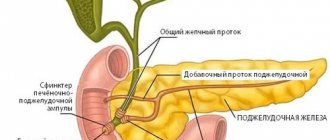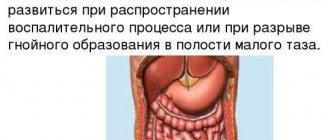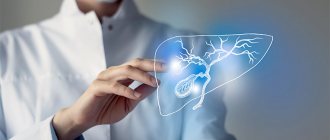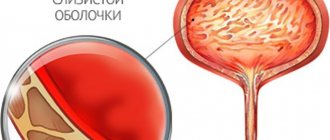A cholecystectomy is an operation to remove the gallbladder. Currently, many techniques have been developed for this operation. Preference is given to minimally invasive (laparoscopic) interventions, as they reduce the risks of postoperative complications and minimize rehabilitation time. However, in some hospitals the routine operation is still laparotomy cholecystectomy, which is performed through incisions in the abdominal wall.
- Why is the operation performed?
- Indications and contraindications for cholecystectomy
- Types of surgery
- Operational risks
- Postoperative period
- Diet
Why is the operation performed?
The gallbladder is an important part of the digestive system. Bile collects in it, and when food enters the small intestine, the bladder contracts and throws out 40-60 ml of its contents. Bile promotes the activation of digestive enzymes, emulsifies and hydrolyzes fats, and removes excess cholesterol and bilirubin from the body.
If pathology occurs, the gallbladder can cause severe disorders, from pain to damage to the liver, pancreas, and even the development of severe septic complications. A timely operation according to indications allows one to avoid the development of severe complications and at the same time does not significantly worsen the patient’s quality of life in the future.
Contact litholysis
This is an operation to remove stones with complete preservation of the organ. When the underlying disease is cured, it has a very good prognosis. In Russia, the technique is under development, most of the operations are carried out abroad.
It includes several stages:
- Application of a microcholecystotomy. This is a drainage tube through which the contents of the gallbladder are removed.
- Assessment by injection of a contrast agent of the number and size of stones, which allows you to calculate the exact amount of litholytic (solvent) and avoid its entry into the intestine.
- Introduction of methyl tert-butyl ether into the cavity of the gallbladder. This substance effectively dissolves all deposits, but can be dangerous for the mucous membranes of neighboring organs.
- Evacuation through a bile drainage tube with litholytic.
- Introduction of anti-inflammatory drugs into the cavity of the gallbladder to restore the mucous membrane of its walls.
Indications and contraindications for cholecystectomy
The most common indication for this operation is the development of complications of cholelithiasis (hereinafter referred to as cholelithiasis) and some acute pathologies of the gallbladder (GB):
- Acute cholecystitis. If left untreated, it can cause severe complications, including the development of peritonitis, abscesses and sepsis. If there are no stones, the patient can be managed conservatively. But with calculous acute cholecystitis, emergency surgery is indicated.
- Choledocholithiasis is the presence of stones in the bile ducts. In this case, obstruction (blockage) of the ducts and the development of a serious complication - obstructive jaundice - are possible. In addition, cholangitis and pancreatitis develop. During the operation, not only the gallbladder is removed, but also the bile ducts are sanitized. In some cases, drains are installed.
- Symptomatic cholelithiasis. The absolute indication for surgical intervention is hepatic colic due to cholelithiasis. It is also recommended to remove the bladder for other symptoms: bitterness in the mouth, as well as heaviness or aching pain in the right hypochondrium.
- Asymptomatic cholelithiasis. Previously, it was believed that in the presence of stones, cholecystectomy was indicated in any case, since doctors were afraid of the development of a malignant neoplasm against this background. But further observations showed that the likelihood of malignancy is low. Now removal is recommended only for the following indications: if the size of the stones exceeds 2.5-3 cm, and if the patient’s life expectancy is 20 years or more. In the latter case, the likelihood and severity of long-term complications are higher than the risks of surgery.
- Calcification of the gallbladder - deposits of calcium salts. It is complicated by the development of a malignant neoplasm in almost 25% of cases.
- Cholesterosis of the gallbladder is the deposition of cholesterol in the wall of the bladder. Cholecystectomy is performed for calculous cholesterosis and/or when its functionality is impaired.
- Gallbladder polyps. Surgery is indicated if the polyps are larger than 1 cm in size, or if they have a vascular pedicle. In other cases, dynamic observation is carried out.
Planned operations are not performed if the patient has acute infectious diseases or decompensation of chronic pathologies. If emergency intervention is necessary, the benefit/risk ratio is assessed individually.
Preparing for laparoscopic gallbladder removal
Preoperative tests are recommended to be done no later than two weeks before the planned date of gallbladder laparoscopy. The patient should be provided with the results of the following studies:
- general blood and urine analysis;
- biochemical blood test with determination of the concentration of total protein, glucose, bilirubin, glucose and alkaline phosphatase;
- coagulogram (APTT, INR, PTI, fibrinogen);
- Wasserman reaction, tests for the presence of antigens to HIV, as well as hepatitis types B and C;
- electrocardiogram.
- Gastroscopy
- Ultrasound of the abdominal organs
If the test results are within normal limits, the patient is allowed to undergo surgery. It is necessary to coordinate the use of any medications with the operating surgeon and anesthesiologist. On the day before surgery, it is recommended to finish eating by 6:00 pm and drinking liquids by 10:00 pm. After this, the patient is not allowed to take water or food until the start of the operation. No other preparation is required for laparoscopic gallbladder removal. Some clinics continue to perform cleansing enemas before surgery, but there is no point in this.
Types of surgery
There are two types of cholecystectomy practiced in Russia:
- Laparoscopic - all manipulations are performed through small punctures using endoscopic equipment. Currently, this technology is the gold standard for elective interventions in the absence of significant inflammation and adhesions.
- Laparotomy, or traditional open. It is carried out in case of adhesions and severe inflammation.
Let's consider each of the methods in more detail.
Laparoscopic cholecystectomy
The technique of this operation consists of making 3-4 punctures on the abdominal wall, through which hollow tubes (trocars) are inserted into the abdominal cavity, and through them instruments - a video camera, manipulators, clamps, electrodes, etc. Modern video cameras allow you to obtain high-quality detailed enlarged images, which is broadcast to the monitor. This allows for better visualization than with open abdominal surgery.
In order to have sufficient visibility and space for manipulation, the abdominal cavity is expanded using gas. Its insufflation (pumping) is carried out throughout the operation through a separate trocar. Next, the gallbladder and its structures are isolated. Its artery is ligated, its neck is cut off, and the bladder is removed through one of the trocars. After this, an inspection is carried out, the gas is sucked off and the tubes are removed. Drainage is installed in the wound, the punctures are sutured and sealed with a sterile plaster and bandage.
Advantages of laparoscopic surgery:
- Very low risk of abdominal wall trauma.
- Postoperative pain syndrome is practically absent.
- Very fast recovery and short hospital stay.
Traditional cholecystectomy
This operation (laparotomy cholecystectomy) is performed through an incision in the right hypochondrium or along the midline of the abdomen. It provides good access to the entire hepatobiliary system - extrahepatic ducts, pancreas, duodenum. This allows for all types of revision - from duct probing and intraoperative ultrasound to choledochoscopy. Most often, such operations are performed in cases of serious inflammatory processes, in particular peritonitis and abscesses.
There are situations when laparoscopic surgery is initially planned, but in the process of performing it, surgeons see serious complications and are forced to switch to open access. This situation is called conversion.
What to take with you to the hospital?
With laparoscopic cholecystectomy, hospital stay rarely takes more than two days, so the number of things can be minimal.
Here is a list of necessary things
for hospitalization:
- 1.Passport and insurance policy
- 2.Medicines that you take regularly
- 3.Personal hygiene products
- 4.Comfortable change of clothes and linen
- 5.Anti-embolic compression stockings
- 6.Phone charger (and the phone itself)
Operational risks
Cholecystectomy, like any other operation, may be accompanied by the development of complications and unwanted reactions. They can be divided into several groups:
Complications from the wound:
- Hematomas and hemorrhages.
- Wound infection. Accompanied by redness of the skin, thickening and the release of pathological discharge. Requires urgent medical attention.
Complications from the abdominal cavity:
- Residual choledocholithiasis. As we know, gallstones can form not only in the gallbladder, but also in the ducts. At the preoperative stage, they try to detect them and solve this problem during cholecystectomy. But in some patients it is not possible to detect stones either preoperatively or intraoperatively. Remaining stones can cause complications, such as obstructive jaundice. Then repeated intervention is required.
- Bile leakage. In the early postoperative period, bile may be separated from the gallbladder bed. To divert it, a drainage is inserted into the wound at the end of the operation. Usually this situation lasts 2-3 days and stops on its own. The only thing required here is observation in a hospital.
- Damage to the bile ducts. As a result, bile leakage may develop. Then the drainage discharge remains for more than 2-3 days. In this case, repeated surgery and long-term rehabilitation are required.
Despite the fact that any surgical intervention may be accompanied by the development of complications, it is still worth noting that their risk is negligible when the operation is performed by an experienced surgeon in a well-equipped operating room.
Possible complications
Thanks to proven techniques, cholecystectomy proceeds safely, but in some patients complications are possible for various reasons. Medical tactics depend on them (for example, nutrition a month after removal of the gallbladder in the presence of adhesive disease should still be light). The most common complications:
- injury during bile duct surgery;
- leakage of bile;
- suppuration of a postoperative wound;
- intra-abdominal bleeding;
- thromboembolic conditions;
- formation of adhesions.
Complications require immediate correction.
On our website you will find answers to all questions, for example, what drugs are used for treatment after removal of the gallbladder or how the postoperative period goes in the elderly.
Related services: Surgical operations Laparoscopy
Postoperative period
Features of the recovery period after surgery are determined by the technique of its implementation. With laparoscopic intervention it is relatively easy. After just 6 hours you can sit down on the bed and gradually get up under the supervision of medical staff. The next day you can safely move around the department. As for food, they begin to eat light food on the second day after cholecystectomy. The drainage can be removed on the same day. On average, recovery takes about a month, but the time frame may increase depending on the general condition of the patient. Open surgeries sometimes require longer bed rest and pain relief.
Patient reviews
The main question on forums dedicated to cholelithiasis is whether or not it is worth having surgery. Unfortunately, organ-preserving intervention methods have not yet been perfected, and you have to compare risks and make difficult decisions. Different doctors may have their own opinion about the need for surgery and the time frame for it to be carried out.
Laparoscopy has earned many positive reviews. Patients are satisfied with the absence of stitches and the quick recovery time. Those who have experienced colic and severe pain associated with a stone entering the duct are pleased to note a feeling of lightness and comfort.
Surgery today, unfortunately, is the only effective way to get rid of cholelithiasis. Despite the development of minimally invasive and organ-preserving surgical interventions, in most cases it is necessary to resort to removal of the bladder. The operation has a number of complications, some symptoms can haunt patients for the rest of their lives, but they cannot be compared with the pain caused by stones.
Diet
An important point in the recovery period is diet. During this period, it is recommended to give up alcohol, heavy foods (fats, marinades, smoked foods), and light carbohydrates. Small meals 4-6 times a day are recommended.
In the federal network of expert oncology clinics “Evroonko”, cholecystectomy is performed laparoscopically if there are no contraindications. We use expert-class equipment, staffed by highly qualified specialists.
Book a consultation 24 hours a day
+7+7+78
When is laparoscopy used?
The procedure can be used to diagnose a wide range of diseases that develop within the abdomen or pelvis and perform surgical procedures. It is used to remove damaged organs or parts thereof, as well as to perform a biopsy - taking a tissue sample for further study in the laboratory.
Most often, laparoscopy is used in the study and treatment of conditions and diseases in the field of: – gynecology – the field of the female reproductive system; – gastroenterology – digestive system; – urology – urinary system: kidneys, ureters, bladder and urethra.
When to seek medical help?
Doctors recommend that patients not be left alone during the first 24 hours after surgery; it is advisable to have someone nearby who can provide assistance if complications develop.
You should contact your doctor if the following symptoms appear:
- temperature rise to 38°C or more;
- chills;
- severe or continuous vomiting;
- redness, pain, swelling, bleeding or discharge from wounds;
- unusual discharge or vaginal bleeding;
- increasing abdominal pain;
- burning or tingling when urinating;
- pain or swelling in one of your legs.









